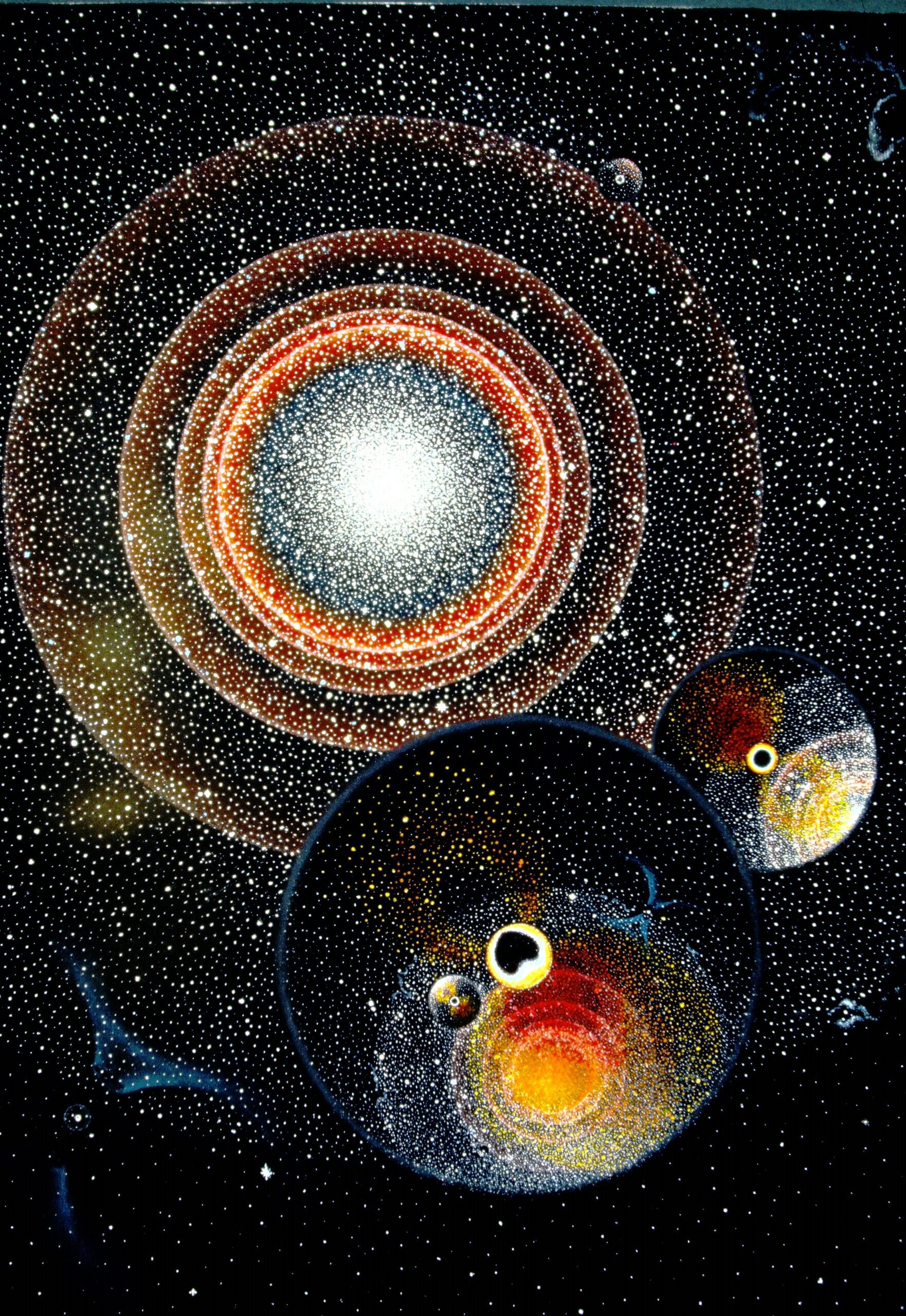Light and Lenses
by Dr. Robert Duncan-Enzmann
Image: Painting – Gravitational Lensing by Don Davis and Enzmann
The editor found these notes in a spiral-bound book of papers. Light is a wondrous, magical thing. Light is associated with warmth, intelligence, enlightenment, and life itself. Light reflects, refracts, and emits in rays. Our eyes receive light, lenses manipulate light, and photography is the art of capturing light. Written about 1950s
Diffraction
Lenses making use of diffraction are among the oldest in the world. The Pin Hole camera is the best-known example. Less well known are Bee-Bee cameras, in which the light is diffracted about a tiny sphere supported by filaments.
Diffraction can increase the effective size of a mirror. How astonishing to see around a corner just using your finger. It works. It is startling – to increase the width or height of a mirror, to see around a corner by holding your finger in your field of view and moving it toward the edge of a mirror.
The effective sizes of both flat mirrors and curved telescope mirrors can be extended by refraction. Similarly, such plants as evergreens extend their effective sizes by diffraction, and mariners find some measure of safety and relief from storms by mooring – or standing at rest – on the flanks of a peninsula.
Why should this be? How can this be?
The leaves are subhedral, angular, they have V-shaped clefts. How then is the light patterned into circles?
The light on forest floors is diffracted. The spaces between leaves act as does a pinhole camera. The round and sub-rounded patterns of light are images of the sun.
Temperate forests have but one canopy. The might tropical forests are not just treasure houses of strange plants and animals, but also physical laboratories in which the properties of light are wonderfully developed. Tropical forests usually have three, sometimes four, and occasionally – int those rare places untouched by mankind – five canopies.
One canopy can only be as thick as shadowing permits. A second canopy can only form at a distance far enough down from the first such that light has formed a diffraction pattern of circles. This is why there is an empty space between canopies. The pattern can repeat several times.
Reflection
Said the professors at the Platonic University to the Mighty Men who spiritually guided the church: “If the Moon were perfect, we would see it only as a brilliant spot in the heavens.” He continued, “Why does the Sun form rays in the atmosphere when it is amidst the clouds?”
The ‘Fathers’ of the church were furious. The heavens were perfect. Mankind should be directed toward credibility. The heavens were perfect. Knowledge was evil.
Swiftly was the matter resolved, the ‘Christians’ burned-out libraries at Athens, Corinth, Rome, Alexandria, Marseilles, and all other national, state, city, and private libraries they could lay their hands on. Schooling was stopped, reading in itself became a crime for almost a thousand years.
Universities were destroyed, professors executed with a few fortunate exceptions who were imprisoned or allowed to spend their lives at hard labor. The Greek educational system of elementary, grammar, and high school, and post national service was abolished – not to appear again until the 1800s.
The Church ‘Fathers’ had their way. The Heavens were perfect. The Moon was a flawless sphere. So perfect were the Heavens that there is not a single report of Haley’s Comet in Medieval literature. After all, it could not exist in the Heavens, for they were perfect and unchangeable.
Note: A curious exception is a needlework we call the Haley’s Comet Tapestry. But after all, this was a vision of females – the weaker, inferior sex – what girl could understand the perfection of the heavens.
Wonderful indeed is the raying sunlight amidst the clouds. How can this happen? It is related to the nature of perfect spheres which the long-dead and long-hated Platonic Philosophers discussed.
How curious that no matter where we stand on the landscape the rays in the atmosphere seem to point right toward the Sun. It is not a small matter to explain this.
Here are some clues:
When driving at night the windshields of cars with tiny droplets upon them will develop rays that point right toward the eye of the driver, or passenger.
The next clue is the sky itself. If raying is looked at very carefully it will be seen that there are both easily seen light rays and also less-apparent dark rays amidst the clouds. Regardless of where the observer stands, both the brilliant light rays and the faint dark rays will point directly toward the Sun.
A last and most important clue is found in the beautiful silvered spheres that gardeners love to place near sundials, pools, and little glades and gardens in their works of art. How brilliantly the spheres reflect the Sun. Like windshields in a parking lot on a clear day, the silvered spheres reflect a tiny image of the Sun toward the viewer. You can scarcely escape it. This is what Plato said the Moon would look like if it were indeed perfect. Plato claimed that the Moon must have a rough surface.
Lenses in Nature
There are lenses in nature. Is it possible that there are natural photographs, somehow left behind from natural lenses for mankind to discover?
Lenses are not simply inventions of the wonderful world of animals. Lenses are used by plants. They are, in the slowly evolving world of plants, a rather recent development.
Plants of earlier times used simpler techniques of absorption. Early on they formed structures that could enhance absorption with diffractional effects.
Evolution continued with the development of what seems to be a combination of Light Pipes – developing naturally hundreds of millions of years before mankind happened upon fiber optics – and bionic Lenses, known to the Greeks and patented by R. D. Enzmann. Natural ‘fiber optic fibers’ are found on Polar Bears; whose fur is not fur but clear tubing. It is likely this coat of fiber optics channels the sun to the skin of the animal.
Lenses are common, almost all leaves of deciduous trees develop them. Could there be photographs?
Distorted lenses are abundant among the tiny silica-rich structures called phytoliths, which are found in almost countless quantities in the soils of the world. They are very tiny, often just barely visible to the eye, even tiny when viewed with a hand lens. One might ask: Can such a small thing act as a lens? Can that be, can a microscopic structure manipulate light?
It can. Indeed, it can. Consider the eye spot of a Paramecium. Fibrils are connected to it. Careful observations suggest that up to 500,000 contacts are made between fibrils and eyespots. It is possible that the critters not only respond to light with heliotropic reflexes, but also form images!
It is possible. 500,000 contacts suggest that the daring observers who jokingly say ‘I’m looking down through a microscope, and sometimes it seems as though one of those things looks back up at me as though the microscope were a telescope from where it is!’ might be right.
The lenses are there. Are photographs lying there as well? Waiting to be discovered? What a stunning discovery if there are natural photographs from millennia ago. Think of looking back at the walls of Troy or viewing our ancestors of 28,000 years ago who hunted mammoths, carved figurines, even molded and kiln-fired ceramics. Think of the pictures that could be recovered.
It is asking a great deal to search for such a view; but could the field of Photo Archaeology be established as a science by demonstrating in principle that such photos exist, and finding a few such images? They could even be quite crude, but if only the supposition can be demonstrated as valid – if only that – then armies of workers will march along the suggested trail.
And then, such wonderful images such as Rhodes in the days of Alexander might be brought back for all to see.





